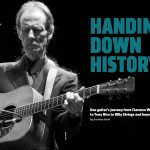(It’s a long long way) To the top of the world – Almost Acoustic and Ragged But Right
Review by Douglas Heselgrave
Jerry Garcia meant many things to many different people and the pressure took its toll on him. By 1987, he had long outgrown the ‘Captain Trips’ persona that he was saddled with at the height of the psychedelic era, but for the literally millions of fans the Grateful Dead picked up during the last decade of their thirty year run, he often existed as a symbol of 1960’s hedonism and not as an evolving artist and human being. Freshly clean of heroin after more than a decade of debilitating addiction, by 1987 Garcia was firing on all cylinders and was clearly looking beyond the horizons defined by his membership in the band that made him famous.
It was a difficult situation to wiggle out of. If ‘In the Dark’ hadn’t been such a surprising success and if ‘Touch of Grey’ hadn’t ripped up the FM radio charts the way it did, very few may have noticed Garcia gracefully bowing out of his leading role in the band to pursue interests closer to his heart. As it was, 1987 saw the Grateful Dead on the cover of The Rolling Stone, touring with Bob Dylan as well as exceeding all previous record sales levels and becoming the most successful live act in popular music. From the outside, little of it made sense. But, somehow The Grateful Dead who had always happily existed as little more than an adored cult band broke into the mainstream with Garcia identified as the band’s unwilling figurehead.
It would be a mistake to say that The Dead were over the hill by 1987. Their sound had changed and streamlined to fit the times, but on a good night they were still a live act to be reckoned with. Their growing legions of fans often had no point of comparison or expectations to hold them to, and as a result concerts were often treated as ‘events’ rather than musical experiences robbing the band of the critical give and take that their core audience had always provided. As the group needed to book themselves into bigger and bigger venues to accommodate the huge numbers of people who wanted to see them, it became more difficult to maintain the incredible magical vibe that had previously defined Grateful Dead concerts. The displeasure that this caused Garcia was something that he made no secret of, and he began to seek new and interesting musical connections outside of the group.
This was nothing new. From the beginning, many of the members of the Grateful Dead maintained side projects and if one looks at Garcia’s forays outside of his main group, the trajectory that lead him to creating the Jerry Garcia acoustic band makes perfect sense. Like many people of his generation, he was deeply influenced by folk music and Harry Smith’s Anthology of ‘old weird’ American tunes. This lead him to forming ‘Mother McCree’s Uptown Jug Champions’ with Bob Weir and Ron ‘Pigpen’ McKernan in 1964 before they morphed into the Grateful Dead the following year.
For a time, Garcia’s interpretations of traditional Americana fell to the wayside as the heady psychedelic wave they crested on eclipsed everything else. Then, after the fallout of Woodstock and Altamont, the yin and yang polarities of the decade’s musical and cultural growth, the Grateful Dead took it down several notches by recording the acoustically tinged ‘American Beauty’ and ‘Workingman’s Dead’ albums. These offerings remain the best selling items in their back catalogue, and opened the door to further acoustic explorations on Garcia’s part with ‘Old and in the Way.’ This old timey band featuring blue grass stars David Grisman on mandolin, Pete Rowan on guitar and Vassar Clements’ on fiddle, encouraged Garcia to pick up the banjo and explore new musical dimensions in an ego free environment. Old and in the Way was the perfect vehicle for Garcia as it introduced him to a new audience of bluegrass fans that were often not aware of his work with The Grateful Dead, allowing him to be judged solely on his musical prowess and not by his cultural cache. The collective recorded one excellent album before folding in 1974 when the renewed intensity of the Dead’s touring and recording schedule made it impossible for him to keep both bands afloat.
From 1974 to 1980, Garcia kept his acoustic identity mostly hidden in the closet – though concert versions of folk songs such as ‘Pretty Peggy O’ and ‘We Bid you Good night’ hinted at the deep well of traditional soul lurking beneath the increasingly complex improvised music the Dead unleashed on their audience. In 1980, for their 15th anniversary tour, the Dead often incorporated acoustic sets into their concerts and old chestnuts such as ‘Deep Elem Blues’, ‘Dark Hollow’ and ‘Babe, It ain’t no Lie’ were often the stand out highlights of the evening’s setlists. ‘Reckoning’, the acoustic souvenir from this tour remains one of the most essential releases in the band’s catalogue and should be in everyone’s record collection.
The years from 1980 to 1986 were murky ones in Garcia’s personal and professional history. Despite some excellent performances and successful tours, the band’s vision began to flounder as Garcia fell deeper and deeper into a paralysing addiction to cocaine and heroin. It wasn’t until things hit a crisis point precipitated by Garcia’s falling into a diabetic coma that things began to improve. The incident forced Garcia onto the sidelines and into a forced reassessment of his priorities. The coma had robbed him of his ability to play guitar, and he had to slowly piece himself together with the aide of friend and Jerry Garcia band organist, Merle Saunders who patiently coached him back from the edge to reclaim his unique musical voice and vision.
A few months later, Garcia was itching to play live again and as a celebration of his return, Bill Graham, the famed west coast impresario, booked him into a theatre on Broadway for several nights running. His electric band was the headliner, and as the result of a fortuitous set of circumstances Garcia decided to ‘open’ for himself with an impromptu acoustic band that he’d thrown together. He was originally encouraged to play solo, but after only one uncomfortable set with no other musicians to play off of, the Jerry Garcia acoustic band was formed in an ad hoc manner. Playing with his regular bassist, John Kahn and New Rider’s guitarist, David Nelson reminded Garcia of the deep territory to be explored in American traditional music. Along with Sandy Rothman on strings, Kenny Kosek on fiddle and David Kemper on percussion, the band played approximately two dozen concerts over the next year or so. Not nearly as celebrated as either ‘In the Dark’ that came out the same year or his subsequent reunion with David Grisman (which resulted in five very worthwhile albums) a few years later, to my ears, the music played by the Jerry Garcia Acoustic Band remains amongst the very best of all of Garcia’s considerable body of work.
The playing is sometimes ragged; mistakes can be heard everywhere. Notwithstanding that, the sheer joy that permeates every note the often rag tag band plays is absolutely exhilarating. For many years, ‘Almost Acoustic’ the 1988 release culled from three San Francisco concerts was the only official recording available from this short-lived band. A few years ago, Garcia’s family released two recordings from the Broadway run as ‘Pure Jerry’ volumes 2 and 3, but they were not very widely circulated and suffered from a lack of judicious editing that made the set almost overwhelming to all but the most hard core fans. The newly released ‘Ragged but Right’ was compiled by Sandy Rothman nearly 20 years ago after the initial success of ‘Almost Acoustic’, but has not seen the light of day until now. It is a much better companion set than the Pure Jerry series offerings and flows much better from song to song, giving a much clearer sense of the band’s playfulness and agility.
Both ‘Almost Acoustic’ and ‘Ragged but Right’ are wonderful albums and they go extremely well together. Of the two, ‘Almost Acoustic’ is the better collection, hands down. There’s not a bad track amongst the fourteen songs collected here as songs from The Stanley Brothers, Merle Haggard, Jimmy Rogers, Mississippi John Hurt and Elizabeth Cotton are all brought to new life by the band. The album opens with a thoroughly exhilarating ‘Swing Low Sweet Chariot’ that showcases the collective’s deep intuitive understanding of bluegrass harmonies. After setting the bar so high, the highlights keep coming thick and fast with defining versions of ‘Spike Driver Blues’, ‘Blue Yodel No.9’ and ‘Oh, Babe it ain’t no lie.’ If one was forced to choose one song that stands out from the rest, it would have to be the incredible take on ‘Deep Elem Blues’ that features a guitar solo from Garcia about four minutes into the performance that pretty much defies belief. It perfectly encapsulates Garcia’s uncanny sense of melody and his staggering ability to play just the right note to illuminate the emotional heart of a song. Of all of the hundreds of Garcia performances one could choose from, this one stands out. The only song from The Grateful Dead’s oeuvre that makes it onto ‘Almost Acoustic’ is an uplifting version of ‘Ripple’ that clearly underscores the surprisingly unbroken line that connects artists like Doc Boggs to San Francisco psychedelia.
‘Ragged but Right’ may seem like a bit of a letdown after ‘Almost Acoustic’, but it is worth listening to for many reasons. Firstly, it features fourteen songs primarily plucked from the Broadway run that emphasise a different side of the band’s performances. Many of the songs like ‘Bright Morning Star’, ‘Drifting too far from Shore’ and ‘It’s a long long way to the top of the world’ explore the rootsy gospel music that Garcia loved so much and broaden the listener’s perspective of what the group could do. By this time, Garcia’s voice was cracked and husky – ragged but right to be sure – yet, the spirit and soul that comes through in his performance is a joy to hear. Of the remaining songs, the uplifting version of ‘Short Life of Trouble’ is one I’m sure that people will never tire of. The only repeat track from ‘Almost Acoustic’ is an alternate version of ‘Deep Elem Blues’ that emphasises vocal harmonies rather than Garcia’s guitar work.
It has been fifteen years since Jerry Garcia’s death, but he still remains a hugely misunderstood figure. ‘Sixties cliché’, ‘drug casualty’, ‘a victim of his own excesses’ – one doesn’t have to dig very far on the Internet or into the many books written on the guitarist’s life to see how obscured Garcia’s artistic output has been hidden underneath the considerable weight of the myths surrounding him. All of these years later, and it is disheartening to see how many writers and cultural commentators still try to force him into a box that is far too small to describe his expansive vision. It may be many years or decades until his contribution to music is fully appreciated on its own terms. Releases like ‘Almost Acoustic’ and ‘Ragged but Right’ go a long way towards achieving that goal.
This posting also appears at www.restlessandreal.blogspot.com
Sign up for free updates





